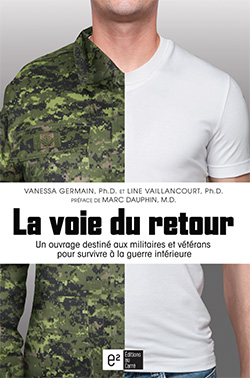Book Reviews

La voie du retour: Un ouvrage destiné aux militaires et vétérans pour survivre à la guerre intérieure
by Vanessa Germain, Ph.D., and Line Vaillancourt, Ph.D.
Montreal: Éditions au Carré, 2016
248 pages, $24.95
ISBN: 978-2-923335-75-9
For more information on accessing this file, please visit our help page.
Reviewed by Dave Blackburn
I must start by saying that I had very high expectations of this book – first, because it addressed a significant gap in the field of operational stress injuries and their treatment; second, because a work like this, written in French specifically for Francophone military personnel, military families, and veterans, is a rarity in Quebec.
The authors have enviable reputations in the field of mental health, particularly in the treatment of operational stress injuries, and that heightened my anticipation. So did the fact that the preface was written by my friend Marc Dauphin, with whom I served in Germany in 2007–2008. Not only is Marc an outstanding doctor and an accomplished author, but he has also experienced the suffering caused by an operational stress injury. His association with this book was an indication that the quality of the finished product should be excellent.
I read La voie du retour: Un ouvrage destiné aux militaires et vétérans pour survivre à la guerre intérieure from cover to cover in a few hours. It is a very easy read, written in accessible language. To be honest, I had been expecting a more theoretical work; instead, it leans more toward the practical and includes exercises. The theoretical passages are often very brief, barely scratch the surface of the subjects addressed, and are not always based on the most current work in the field. The bibliography is also quite limited for this type of book. I would not say I was disappointed, but I was expecting something more fully developed, even though I knew that the book was intended for a general audience. However, my personal expectations do not in any way change the fact that this is a very interesting, high-quality work.
It is important to note that La voie du retour is intended for neophytes in the field of mental health and operational stress injuries, particularly military personnel and veterans who would like to gain a better understanding of some of their own reactions, emotions or behaviours that may be linked to their mission in a theatre of operations. The authors have done an excellent job of simplifying some complex mental-health concepts and of suggesting reflection activities, practical exercises, and strategies for improving well-being. Therein lies the book’s strength and uniqueness.
For military personnel who return from a mission and wonder about its impacts on them, La voie du retour will provide some answers, de-stigmatize some of their reactions, and help them make connections between their mental health and their work in the military. It might even lead them to consult a mental health professional. Having worked in the Canadian Armed Forces, I am well aware that mental health is still a taboo topic in the CAF today. This book offers information and raises awareness on the subject. It will help readers understand that it is possible to have “normal” mental and behavioural reactions to “abnormal” events in life. Military operations are generally carried out in settings where personnel are likely to be exposed to potentially traumatic events.
The book deals with a multitude of topics directly related to operational stress injuries and operational missions. On the one hand, the large number of topics makes the book highly relevant and provides a useful overview. On the other hand, the coverage lacks depth. Some chapters are only a few pages long, including some on subjects as important as post-traumatic stress disorder, anger, and other emotions. I understand that this is a work for a general audience and should be considered as complementary to, or a precursor of, mental health services provided by professionals, but in my opinion it could and should have been more fully developed.
The same is true of the sections for families: they are much too short and move through the topics too quickly, especially given that family members of military personnel are often the indirect “victims” of the day-to-day repercussions of operational stress injuries and that, in their own way, they too participate in the operational missions. As I have said before, the men and women who deploy on missions receive medals when they return, and so should their families. Had more space been devoted to the issues and challenges faced by family members, it would have added to the book’s value.
In conclusion, I encourage all brothers and sisters in arms and all veterans who are wondering about their personal state, their emotional or behavioural reactions or their mental health to obtain a copy of La voie du retour, read it attentively, and complete the activities and exercises it suggests. Doing so could enhance their personal growth and shed light on the connections between their mental and emotional state and their military mission in a theatre of operations. Emergency services personnel could also benefit from it, since the majority of them participate in operations likely to cause trauma. In addition, it could help readers determine whether they need to consult a mental health professional. Lastly, although the book does not directly address military families, it will be a source of information and awareness for them.
Dave Blackburn is a professor at the Université du Québec en Outaouais (UQO). He has a Ph.D. in social science with a specialization in sociology of health and a master’s in social services. His research focuses on mental health and psychosocial intervention with serving military personnel and veterans. He served as a social work officer in the Canadian Armed Forces and was voluntarily released in 2014 at the rank of major.







